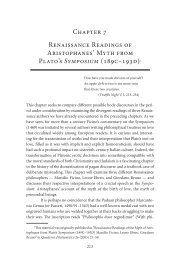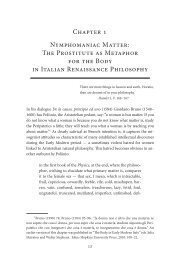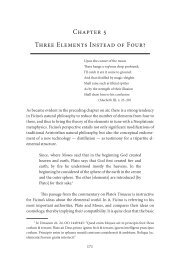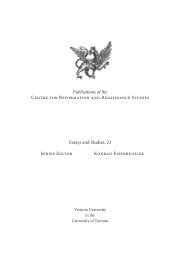Chapter 2 Matter as a Mirror: Marsilio Ficino and Renaissance ...
Chapter 2 Matter as a Mirror: Marsilio Ficino and Renaissance ...
Chapter 2 Matter as a Mirror: Marsilio Ficino and Renaissance ...
Create successful ePaper yourself
Turn your PDF publications into a flip-book with our unique Google optimized e-Paper software.
<strong>Matter</strong> <strong>as</strong> a <strong>Mirror</strong> 93<br />
The hyena’s impressive capacity to avoid the hardships of hunting<br />
(<strong>as</strong> well <strong>as</strong> the annoying sound of barking dogs) is thus due to that animal’s<br />
skilful manipulation of the shadows of things. Needless to say, the hyena is<br />
an animal frequently <strong>as</strong>sociated with magic; according to Ovid “the hyena<br />
can change its sex, the female that lately allowed the male to mount her becoming<br />
now a male herself.” 143 This is an important detail, since it reminds<br />
us of the mirror’s capacity to transform something from p<strong>as</strong>sive object into<br />
active subject. Hence the hyena’s ability to affect other sentient beings by<br />
manipulating their shadows becomes a model for the manipulation of all<br />
things <strong>and</strong> provides a theoretical b<strong>as</strong>is for magic. <strong>Ficino</strong> consequently parallels<br />
the qualities of matter <strong>and</strong> mirror, that is transformation <strong>and</strong> retention<br />
of the received forms, <strong>and</strong> subsequent reflection (birth) of new images.<br />
Images do retain some of the power inherent in the things they represent,<br />
albeit to a lesser extent:<br />
Proclus adds that magicians are accustomed to affect things’<br />
images <strong>and</strong> shadows in marvelous ways, <strong>and</strong> by means of<br />
these affected images <strong>and</strong> shadows similarly to affect the<br />
things themselves. It is <strong>as</strong> if the images <strong>and</strong> shadows had some<br />
nature of their own that reached to things <strong>and</strong> that through<br />
this nature a certain mutual sympathy can be achieved. 144<br />
commemorat qu<strong>as</strong>i cognat<strong>as</strong>, eiusmodi naturam habent, sunt enim & ipsae corporum figurarumque<br />
imagines, plurimamque sympatiam, id est comp<strong>as</strong>sionem consensionemque<br />
cum illis ipsis habent a quibus decidunt. Quemadmodum declarant quotcunque Magorum<br />
artes pronuntiant, promittuntque ad idola umbr<strong>as</strong>que conficere. Quid vero dicam<br />
imaginum umbrarumque vires per qu<strong>as</strong> sunt in animalibus ratione carentibus saepe multa,<br />
quae omnem superant rationem? Nam hyenam ferunt calcantem canis in alto sedentis<br />
umbram, illum ex alto praecipitare statim atque devorare.” De amore VII, 4: 246–249, esp.<br />
248; Allen (1989) 189–191, notes that the p<strong>as</strong>sage about the Hyena is from Proclus (1970)<br />
II: 98–99.<br />
143 Trans. Ovid (1955) 345; Metamorphoses XV, 407–410; on the magical power of<br />
the hyena see, for example, Della Porta (1650) I 14 who maintains that the hyena’s fur<br />
deters panthers <strong>and</strong> even makes them lose their hair when wrapped in a hyena’s skin. On<br />
the hyena <strong>as</strong> a hieroglyph of instability, see Horapollo (1531) II: 177: “Instabilem aliquem,<br />
neque in eodem statu permanentem, vero modo fortem & audacem, modo imbecillium<br />
& timidum, cum volunt significare, Hyenam serpentem pingunt, haec enim modo m<strong>as</strong><br />
modo foemina fit.”<br />
144 <strong>Ficino</strong> (1989) 275: “Adiungit Proclus solere magos miris modis afficere rerum<br />
imagines atque umbr<strong>as</strong>, hisque affectis similiter res ips<strong>as</strong> afficere, qu<strong>as</strong>i imagines atque







